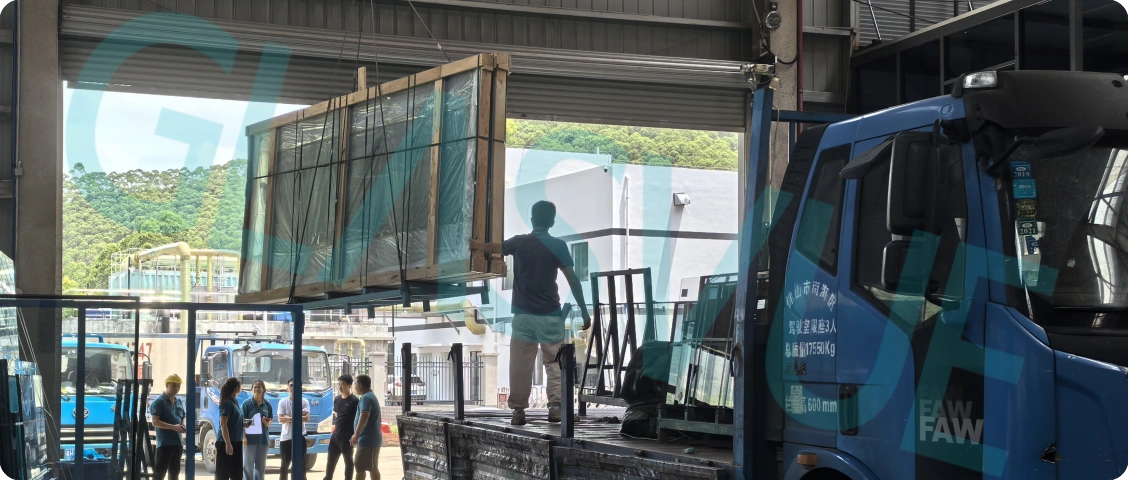In today’s changing world of green building and city projects, window materials play a big part in mixing looks, use, and how well they work. Architects and builders now focus more on making people inside feel good. This is true as city noise gets louder in crowded spots. In fact, online looks for “6.8mm acoustic laminated glass” jumped by more than 40% over the last year. Reports from the Glass Association of North America (GANA) show this rise. It points to a real need for smart materials. These help block noise well. At the same time, they keep energy use low and safety high. All this fits into the main goals of today’s building walls.
This piece looks closely at 6.8mm acoustic laminated glass. It uses a 3+0.76+3 setup. We also check out 11mm insulated glass. That’s the 3+5A+3 kind. Both are top picks for windows, walls, and curtain setups in homes, shops, and tall buildings. We will spot their differences in blocking sound, holding heat, keeping safe, and value for money. Our goal is to help designers, builders, and owners pick smartly for their jobs. Think about fixing up a city office building or choosing glass for a fancy condo. Knowing these small points can make buildings work better. It cuts long-term costs too. Plus, it matches green rules like LEED points.
The effects on building design run deep. Picking the right glass fights outside problems like city sounds and extra heat. It also helps whole building health. This creates spots that boost work and calm. At GLASVUE, We offer higher-quality glass solutions for your project. make sure it fits your building plan from start to end.

Understanding the Basics: Acoustic Laminated vs. Insulated Glass
To get why each glass works well, we need to know their main builds and stuff they’re made from. Both are made for today’s building uses. But they fix different issues in sound and heat plans.
6.8mm Acoustic Laminated Glass (3+0.76+3)
The heart of 6.8mm acoustic laminated glass is two 3mm flat glass pieces stuck with a 0.76mm PVB layer. This happens through heat and push in a sticking process. The PVB sheet often has bits that soak up sound shakes. It works like a bendy layer that takes in shake energy. Then it turns it to warmth instead of letting it go through. This makes it great for spots that need quiet. Think street-side windows in tall flats or meeting rooms in work buildings.
PVB’s build traits matter a lot. It’s bendy, clear, and sticks tight. So the glass stays whole even if hit hard. This setup does best in city building where blocking noise is key. For example, in spots that mix homes and shops near loud roads. Its main points include great break-proof power. It stops bits from flying. And it cuts sound well. Tests in closed rooms show it drops felt noise by up to 35dB. In building looks, this means quieter insides. It helps room sounds without making frames thick for thin wall setups.

11mm Insulated Glass (3+5A+3)
On the other hand, 11mm insulated glass, or IGU, has two 3mm glass sheets split by a 5mm air space with a spacer. That’s the A for air gap. Edges get sealed with a first and second glue setup. This makes a tight space that blocks heat. You can fill it with argon gas to make blocking better. That’s common in buildings that save energy a lot. Like those that aim for zero net use in shop spots.
The air space works on the idea of caught still air. Air doesn’t move heat well. So it cuts loss from push and flow. You can add low-emissivity (Low-E) covers on one sheet. This bounces back heat rays. It makes the whole thing better. In building terms, this glass does great in places with wild weather. It helps sun plans that don’t use much power. Think schools, health centers, or big glass middle rooms. Its top perks include good U-value scores. Those can hit as low as 1.1 W/m²K with argon. This leads to energy saves that fit tough rules like the International Energy Conservation Code (IECC).
In addition, this 11-millimeter insulating glass also has a certain sound insulation capacity. If the thickness of the cavity is further increased, the sound insulation performance can be enhanced to STC 32-38 or even higher, creating a quiet and comfortable indoor environment. It is suitable for building scenarios such as residences and offices that have requirements for noise control

Performance Comparison Analysis
Now let’s check these glasses side by side on main ways they work for buildings. Numbers come from ASTM and ISO rules. This keeps things solid for building picks.
Sound Insulation Performance
Sound moves in buildings like waves. It depends on how fast, how strong, and how stuff slows it. Acoustic laminated glass uses the PVB layer to slow shakes. Sound shakes make the layer bend. Then it loses energy as warmth. It doesn’t let sound go on.
Insulated glass gives some split from the air space. But thin gaps have shake-back issues. The 5mm air spot gives basic block. Yet it fights hard with low deep sounds like road rumbles.
Real tests with Rw, the sound cut score, show the difference clear. 6.8mm acoustic laminated glass hits 34-36 dB most times. It quiets city buzz for calm home spots or open work areas. But 11mm insulated glass stays at 30-32 dB. That’s okay for quiet towns. Still, it’s not enough for loud places like airports or fast roads. In building sound plans, laminated glass is the pick for LEED points on inside air quality. Those focus on sound hold-back.
Thermal and Energy Efficiency Performance
Ways heat moves differ a bunch. Insulated ones break this way with the space. It cuts push loss by 50-60%. And it lets flow loops hold steady temps.
Adding Low-E covers to insulated glass makes them team up well. The metal layer on the inside sheet sends heat back in winter. The air space stops wet build-up too. This pair can get SHGC, or sun heat gain score, under 0.25. That’s way better than plain laminated glass at about 0.70. For builders chasing zero net aims, insulated glass fits easy into air-flow walls or double-layer skins. It drops cool or heat system needs by 20-30% in mild areas.
Safety Performance
Safety can’t be skipped in building rules like the IBC, or International Building Code. Laminated glass’s PVB holds bits if it breaks. This cuts hurt chance. It’s a plus for slanted glass in middle rooms or railings in public halls. It meets ANSI Z97.1 Class A easy. This boosts life safety in shake-prone spots.
But insulated glass has no built-in break hold. If one sheet cracks, the seal can fail. This leads to clouding without extra safe steps. You can add tough glass. Yet the empty build doesn’t stop falls like sticking does. So it’s less great for busy building parts.
Common Failure Modes and Causes
Top glass can still go wrong if not done right. For acoustic laminated glass, edge split hits wet spots. Too much wet in making weakens PVB stick. Bad edge seals trap dirt like glue left-overs. Bubbles or lines come from not pushing out air full in sticking. Hurried air-pull steps or wet layers let steam out. This marks the clear look in clean walls.
Insulated glass problems focus on seal strength. Clouding or wet build comes from dry stuff, or molecular sieve, getting full. Or gas leak makes “breathe” from press changes. Setup in wet times speeds this. It shows why good spacer bars matter in wall groups. At GLASVUE, our strict checks, like sound-wave tests, cut these risks. This keeps building work lasting.
Economic Comparison
At first buy, acoustic laminated glass costs 15-25% more than insulated. That’s from PVB work. But its thin 6.8mm size fits tight metal frames easy. This cuts make costs in block-by-block jobs. Setup takes less work too. Fewer parts mean quicker on-site joins. That’s key for short city times.
Insulated glass starts cheaper, mainly air kinds. But without Low-E, it adds to energy pay over time. Help plans like ENERGY STAR give back some cash though. Over life, it pays back in cold spots. Acoustic laminated wins in sound-led picks where noise gripes add fix costs.
Application Recommendations
| Application Scenario | Recommended Glass Type | Selection Rationale |
| Standard Residential Buildings | 3+8A+3 Insulated Glass | Light build at fair price gives good heat hold. It meets basic IECC energy wants for home spots or low buildings. No extra load on bases. |
| Thickness-Constrained Spaces (e.g., Apartments, Offices) | 6.8mm Acoustic Laminated Glass (3+0.76+3) | Super thin but sound block top-notch. Fits slim door or window shapes in tight city plans. Here, room save beats wide block. |
| Energy-Focused Curtain Walls or Sunrooms | 3+8A+3 Low-E Insulated Glass | Low-E team with space shines in heat push-back. It cuts run costs for big glass sides in shop or fun buildings. |
These tips match AIA good ways. They make sure glass helps build shape and job, not hurts.
Conclusion
Key Performance Differences Summarized
To wrap it, 6.8mm acoustic laminated glass leads in sound hold (34-36 dB Rw). It also tops safety. This fits shake-care inside builds. But 11mm insulated glass wins on heat work (U-value under 2.0 W/m²K). And energy save. It suits wall-led plans. Wrong ways and money add more picks. Sticking’s edge woes vs. seal weak spots in fill. Costs lean to job size.
No Absolute Superiority—Context is King
No one is always best. It depends on spot needs. Like sound zones in mix towers or heat links in low-power homes. Smart pick lifts building from just work to real change.
Ready to Upgrade? Contact GLASVUE for Expert Service
As a top name in building windows, GLASVUE shapes these fixes to your draw. We mix new ideas with trust for jobs that last years.
Our Comprehensive Installation and Consultation Services
From spot checks on noise maps and heat loads to made-to-fit making with top autoclaves, our group covers all. We do full setup for walls, roof lights, and special splits. Backed by promises better than most. Our talks add build info models to see work. This keeps to local rules and green aims.
Get in Touch Today for a Free Quote
Lift your next build job. Reach us on site for no-cost price talk. Let’s window the days ahead together.

FAQS
Q: Can acoustic laminated glass be combined with Low-E coatings for better thermal performance?
A: Yes, for sure. It’s not as team-strong as in insulated ones. But putting Low-E on laminated cuts U-values by 20-30%. This works for mix uses like sound-care sun spots. GLASVUE suggests this for even building walls.
Q: How does humidity in coastal buildings affect these glass types?
A: High wet speeds split in laminated if edges seal poor. And cloud in insulated from seal breaks. Our shore-grade fixes, with better dry stuff, stretch life. Talk to us for area tips.
Q: What’s the lead time for custom 6.8mm acoustic laminated glass orders?
A: Often 2-4 weeks, by amount and details. For fast build ends, GLASVUE’s own stick shop gives quick make. No drop in good work.



